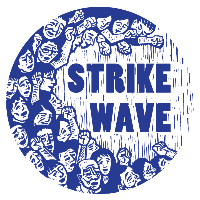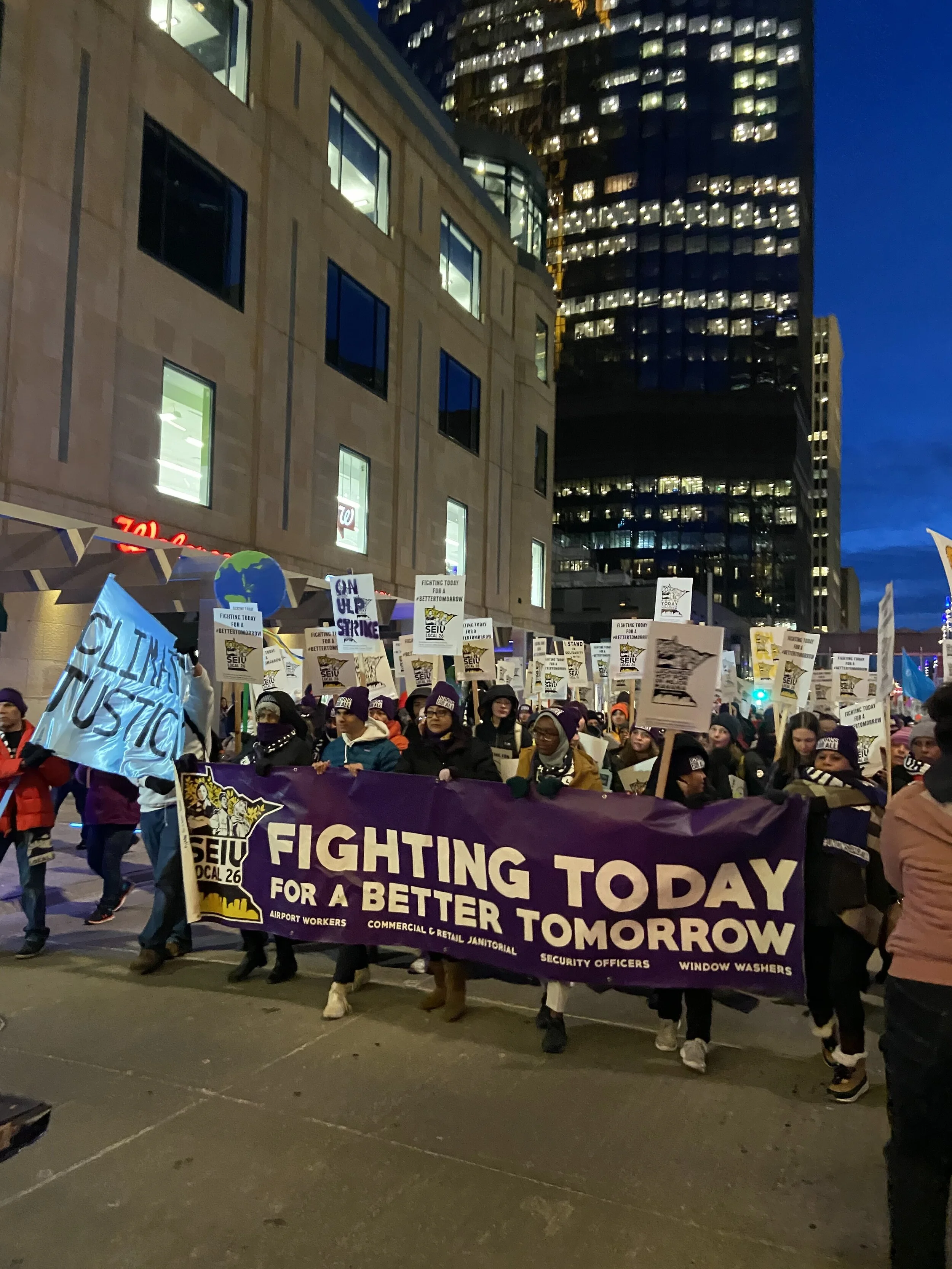Will SEIU Local 26's Climate-Based Demands be the Future of Strikes?
by Caleb Brennan
Credit: SEIU Local 26
As rush hour began in downtown Minneapolis, a huge crowd gathered in front of a pristine department store. The honking cars and brutal, late-February wind couldn’t block out the chants of the protestors. Onlookers gawked from the SkyWay, the massive network of pedestrian bridges that connect skyscrapers, office buildings, and shops.
The protestors held up a variety of picket signs: some demanding fair wages and benefits, others calling for a Green New Deal. A beat-up Ranger pickup truck blasted Latin R&B music from a small PA system. But even in the frigid conditions, morale seemed high. “Oh ya, you betcha, janitor power is coming to get ya!” shouted a burly man in a heavy jacket.
This was how SEIU Local 26, a union that represents janitors, airport workers, window cleaners, and security guards made their strike known. This specific event was meant to highlight the demands of the janitors who clean and maintain huge swathes of the downtown retail and office spaces. Despite four months of negotiations and a contract that expired on December 31st, the eighteen maintenance and cleaning firms that Local 26 works with refused to budge on any of the unions financial demands: six sick days, a $1.50 raise, and a 401k.
Despite the recent passage of the Sick and Safe Time ordinance—a law covering employees who work within the boundaries of Minneapolis for at least 80 hours per year and requiring employers to provide paid leave if they have six or more employees—janitors were only being given three paid sick days.
After thirteen days without a formal contract, SEIU 26 prepared to strike.
“I don’t think (the firms) pay much attention to the workers. We have to say enough is enough. We are human beings and we need their respect. And we are here because we know that we deserve something better,” Elia Starkweather told me. A 43-year-old janitor who has worked in the Ameriprise Financial Center for nine years, she is still living paycheck to paycheck. “I take out the garbage, I pick up the garbage, but I’m not garbage. I am a human being.”
But the strike wasn’t just to improve wages and benefits, the gathering was also about creating solidarity between workers and climate activists. As the strikers marched through the downtown intersections, the crowd was led by a massive silver flag with black lettering: “Climate Justice.”
The janitors had another set of demands that dealt with the environmental impact of their cleaning products and the ways in which the buildings they work in are powered. The waste that they throw out is sent to the Hennepin Energy Recovery Center (HERC), a trash incinerator that helps create electricity for the city. Nationally, the HERC is ranked first in arsenic emissions, second in chromium VI and chromium III emissions, and third in nickel emissions. Burning garbage emits more pollution than coal, and much of the smog carries over into the neighborhoods where these workers live.
“This morning I was taking my kids to school, and my seven year old Sophia was like ‘Mom, that looks like a cloud, but it’s not a cloud, right?’ And I'm like, ‘no, baby, it's a big old thing of smog polluting our air,’" Iris Altamirano, the union's president, said. "A seven year old can put these things together.”
“I'm pretty sure the chemicals that we use at work are harming the environment and we are looking to get training on how to use green chemicals,” Starkweather added.
The union also demanded that the companies they work with help fund a drainage cleaning program, reduce carbon emissions, and add a water and energy conservation plan.
This intersection of labor rights and environmental justice will hopefully serve as a blueprint for unions and workers looking to combat climate change, even as some unions have expressed hostility to calls for a Green New Deal. While groups like Earth Strike have called for a global general strike and Amazon workers launched a wildcat strike to demand better climate action, Local 26’s environmental-based demands are relatively novel.
"When I think of workers rights," Charles Frempong-Longdon, an organizer with Sierra Club who collaborated with SEIU Local 26, explained, "I think about it in these terms: the people exploiting the environment are the same people that are exploiting workers here. We do corporate research and we see that they wear so many different faces. Sometimes we don't recognize them, but they're right on our front door."
The coalition of labor and environmental justice was on full display as the strikers pounded the pavement: every few minutes the marchers would stop to allow one member of the local to speak, and then provide a platform for a youth climate stiker to make their voice heard. “We know that class struggle means climate justice, and climate justice means decolonization!” yelled one youth climate striker.
Not only was this collaboration necessary, but it was effective. As the day of the strike loomed, an agreement was struck on March 7th that met all the unions demands: the raise, the paid sick days, a green education initiative, the use of nontoxic chemicals, and a union-management fund that will study means of reducing carbon emissions.
“We’ve landed the best contract we’ve ever had,” Altamirano said. “This is a win for all of us.”
Caleb Brennan is a writer and reporter based in Minneapolis. You can follow him on Twitter at @CalebmBrennan.

